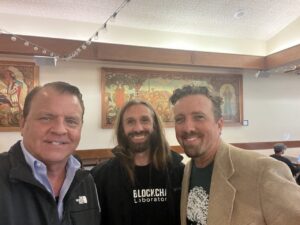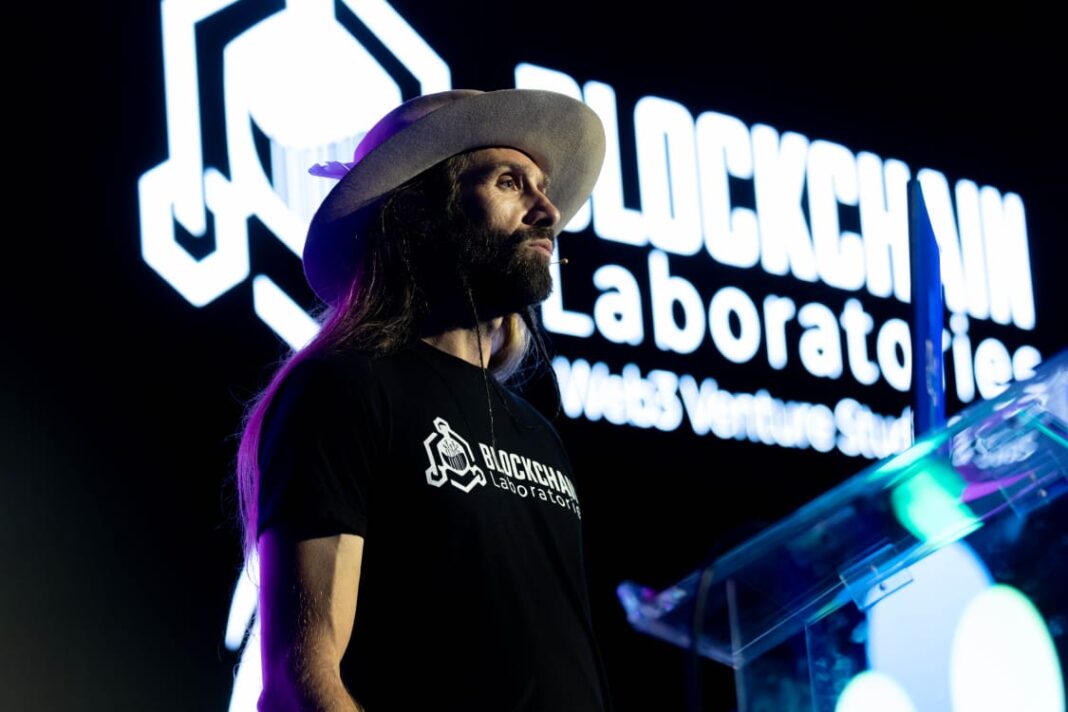Dissecting the fundamentals of new technologies, and their implications, is one of the important needs of society, the general public; for further association, exploration, and being a part of the user base, as Mr. Boone Bergsma mentions the phrase, “Technology doesn’t wait for anyone”, while talking to us, in his recent conversation, where he helps us to decipher and highlighting the developments, and applications that the “Blockchain Technology” brings for the world.
Here are some excerpts from Scientia’s recent conversation with Boone Bergsma. He is the CEO/Founder of Blockchain Laboratories and WeThinkItMatters Inc. Blockchain Laboratories, a Web3 Venture Studio developing Impactful Use Cases of Tokenization and Digital Assets. Boone has led several projects in the past related to blockchain technology; cause-integrated marketing, ESGs, and so on.
Fouz: Hello, Boone Bergsma! Thank you for joining us at “Scientia Pakistan” and accepting our invitation to the interview for our bi-monthly edition of “Blockchain Technology”. We should just get into it. Importantly, firstly please just introduce your work, background, entire venture- “Blockchain Laboratories”-, and the work you guys are doing.
Boone: We started Blockchain Laboratories in April 2021, primarily to be a Web3 Venture Studio and focus on creating real-world tokenization use cases. We were focused on how blockchain and tokenization can be used for social and environmental impact-related use cases.
During the last two years, we have worked on making tokenization easier for small and medium-sized businesses, enterprises, and organizations to adopt. For that, we created a solution that we call W3 SaaS, which stands for “Web3 Software as a Service”. W3 SaaS offers a full suite of tokenization and digital asset management infrastructure. Using W3 SaaS our clients can have all the tools they need to take part in the Web3 era.
Fouz: Sounds, amazing! I think a lot of people are talking about Web3 these days. And, since most of our audience is the general public and people interested in science and technology, let’s discuss the basics. What is Web3? What is Blockchain Technology? In simpler terms, what is tokenization?
Boone: For me, Web3 symbolizes this next generation of the internet. With the earlier Internet, data was stored by centralized parties. Most of the networks and data servers, you know, are usually controlled by one party and if that party happens to have a failure or go out of business or a hack or whatever that might be, everyone’s data is at risk. Also, there could be problems with trust and transparency if one central control over the data. There’s no way to know if things have been changed or what’s happened to that data when you’re not looking.
On the contrary, with blockchain/DLT technology, data is replicated and stored on multiple ledgers. We are talking about storing data on different nodes operated by many different parties that aren’t associated with each other. And tokenization of data makes it immutable, and transparent. Especially, if you’re using public ledgers. To your question, what is tokenization? A token is just a representation of data. It’s a wrapper that goes around something that could be ‘anything’, it could also be a real-world asset like real estate, or it could be a digital asset like an in-game asset.
There are two types of tokens. First, there’s a fungible token, which means all the tokens represent the same thing, which could be carbon credits from the same ecological project. So, all of the tokenized carbon credits from one ecological project, would all, be fungible tokens representing the same issuance. There are non-fungible tokens, NFTs, which represent data of a unique individual item, like a house or car, for example.

Fouz: Great! For the last few years, the cryptocurrency market has been massively booming! Additionally, the NFT market also had some major gains. And everyone was talking about tokens. But, the market seems to be going down lately! How do you see the overall future of Web3 and blockchain? I mean, how do you perceive this?
Boone: I think, everything within the market has cycles. One of the things that drive every industry is regulations. Most industries will not scale at their fullest until there are clear regulations on how that industry can operate.
Additionally, I think, what we’ve seen in the past is, people got excited about Web3 and tokenization. Because of that, it caused markets to climb, and then as we can see, there is a decay of economic conditions worldwide, the rise in the cost of living. The tough circumstances in a lot of places in the world, you’ve got wars going on, all those kinds of things will, will scare people and, depress the markets. So I think that’s kind of what we’re seeing today.
But in my optimistic opinion, I think we are probably a few years away from mass adoption, maybe a little bit more, maybe a little bit less, who knows for sure. But, I think we’re very close to when blockchain and tokenization do become mainstream like other aspects of the internet.
We are going to be driven largely by regulations globally becoming more clear. As the regulations become more clear, we will see a massive adoption worldwide!
Who knows for sure, what the markets will do? But, I estimate the prices that we’re seeing on utility-based tokens of leading DLT networks are probably the lowest. In the future, people will look back and say, “Man, I wish I would have paid more attention and invested”.

Fouz: Exactly, yes! When the technology was in the earlier phases, only a few pioneers and a few people understood what was happening, and what the utility of the tech was. As you mentioned, regulations will become more common. And I think it’s just a matter of time before this becomes mainstream. Related to the work you guys are doing at the Blockchain Laboratories, let’s discuss the ESG use cases.
Boone: ESG stands for Environmental Social Governance; It’s a principle that came out of an earlier kind of “corporate social responsibility” the CSR initiative. The goal was for businesses to analyze how they were doing business and see if there were ways that they could make better choices, whether that’s in manufacturing, supply chain, or even their marketing.
So most of the time consumers will make the buying decisions with their dollars. And generally, consumers over the years have become more concerned with how those dollars will impact the world when they buy a product from a business. In my opinion, ESG is the way for consumers to monitor how businesses are using their profits to make the world a better place.
We all have choices every day where we shop and buy and what companies we support. The way that companies choose or don’t choose to use ESG principles in their business really should be a way that consumers decide on who they want to support and shop with.
Fouz: I have heard a lot about the financial opportunities of blockchain, and about having more real-world applications with this technology. So what types of applications are possibilities?
Boone: Yeah, some of the things that we’re working on at Blockchain Laboratories, is using tokenization and smart contracts and different tools of Web3 for the social impact, and environmental use cases. For example, one of our first clients was a company called Intrinsic Methods.
Intrinsic Methods is a startup, that came from a much older 20-year-old tech company called RootMaker. RootMaker has a scientifically proven patented technology that no matter what tree species you grow in a RootMaker container system, that tree will have a 95% survival rate when it’s planted, and it will grow two to three times faster than the same tree not grown using RootMaker tech.
Intrinsic Methods came to us, and they wanted to create a DLT carbon removal credit registry for reforestation projects that were using RootMaker-certified trees. In this use case, Intrinsic Methods uses NFTs, the non-fungible tokens, to mint decentralized identities (DID) for ecological projects. They’re using NFTs to make the project records permanent and immutable. And all the DMRV (Digital Measuring, Reporting, and Verification) records are also tokenized.
Once the trees have been verified that they’ve been planted on these projects via high-resolution satellite images, the carbon removal credits are issued as fungible tokens. And tokenization of the carbon removal credits brings transparency into the whole lifecycle of the credit history.
Using tokenization and blockchain technology, Intrinsic Methods is helping more landowners and smaller eco projects that would have never been able to take part in the voluntary carbon market because the expenses and barriers to entry are too high for smaller projects.
There’s the other side of things too, another project that we’re working on in the real estate space is a client called DeRE, which stands for Decentralized Reality, and they’re using tokenization to make investing in rental properties more accessible for more people. So right now, most of the time, if you were to try to invest in real estate, you need a lot of money upfront, or just a lot of things have to align for you to be able to get into a real estate investment.
But by using DLT technology and working with DeRE, you can become a fractional owner of rental properties. And for a much lower price point, maybe around a hundred dollars, you can now have partial ownership of a rental property and have a share of rental income and appreciation of the property’s value.
And not to spend too much time, but another example of an in-house venture of Blockchain Laboratories that we’re working on in the real estate industry is called StiffMoney. A lot of people worldwide are paying more money for rent than they would pay for a mortgage if they could qualify for a mortgage, but for some reason or another, they cannot qualify for a mortgage. And so we’re building a platform that’s using crowdfunding principles, and peer-to-peer lending to help people realize the dream of homeownership.
Imagine, you host a crowd-lending campaign to fund buying a house to live in, and 100 or 10,000 or any amount of people could all lend to you in a secure and trustworthy manner. Maybe some of them put in ten dollars, some of them put in thousands, who knows, they could all put in different amounts. In the same way that things like Kickstarter and GoFundMe and other platforms work to crowd-fund different things, we’re building this for the same type of thing for homeownership.
Fouz: You talked about two things: decentralization and regulations. If you could discuss them further. Most experts think that we need stronger regulations. In your opinion, how do you balance these two for your industry? I mean, what should we aim for?
Boone: It’s tough because every country has different priorities and different leadership. And every leader has their own opinions. That’s been one of the reasons for the adoption of DLT and tokenization taking so long. Every industry has good and bad actors, but what has happened though is in tokenization and DLT technology, the media only tried to highlight the bad actors most of the time.
Because a lot of people get their opinions and they make a decision based on what the news tells them instead of doing their research, that I think, a lot of just people were kind of like, well I guess that is what crypto is for. But again, if we go back to what tokenization is, it’s just a better way to store data, in a way that makes it more trustworthy and opens up new ways of moving and transferring value.
I think what is going to happen, the news and media narrative will start to change for the more positive aspects of web3. Not too long ago, Larry Fink, the CEO of BlackRock, one of the world’s largest wealth managers, shared a very pro-tokenization stance. And, they now have one of the largest, fastest-growing tokenized funds. I think that has started to create a little bit more trust in the industry, which was very helpful.
The early days of Web3 were scary for most people because of things that they weren’t used to doing, like having to remember their seed phase for different wallets. People felt somehow something terrible was going to happen and they were going to lose all their money.
What’s happened now is, that the technologies and services built on top of the blockchain have just improved so that now we have things like Multi-Party Computation (MPC) wallets and social logins where now you can come to sites and just use like your Gmail, Twitter, or Facebook account to create a blockchain account and have a smart wallet in the application.
Tokenization is going to be integrated into all the Apps people are already using. One day they’re just going to sign into Twitter or Facebook or Instagram and there’s just going to be a pop-up with new terms and conditions that will say, you now have a wallet, please agree. You’ll click agree and all of a sudden you’ll now plugged into Web3. I think that’s kind of what’s going to spur DLT adoption, in the past you had to make an effort to be part of Web3 but it will be made super easy for you.
In the past, if you wanted to get tokens or use DeFi, you’d have to do your research and figure out how to do it. And now we’re getting to the place where it’s just going to become integrated into all the things that you’re already doing and you won’t even care or know that you’re using tokenization, it will just be part of the internet experience.
Fouz: Well, Since you mentioned the trust part about how Black Rock and I just heard that European MasterCard started having debit cards for cryptocurrencies if I’m not wrong.
Boone: Yes, and PayPal has its own Stablecoin, many legacy brands are integrating web3 services into their businesses now. You are going to see that the transition is starting to happen more and more. And I think just like when the internet kind of had its dot com boom and went from this many users to this many users kind of overnight, that’s where we’re heading in the Web3 era too.
Pretty soon without most people even knowing it, the applications that they’re using today will start adopting blockchain technology and they will just be new terms and conditions and they’ll click the button to agree to, and now they’ll be using Web3.
Also, read: Crips and Strategic Guide to Become a Blockchain Content Creator

Fouz Siddiqui is a writer, academic and scientific management person. Presently, he is a Co-founder and Chief Information Officer at Scientia Magazine. As CIO, he oversees the implementation and strategization of Scientia’s technological and scientific vision. Concurrently, In academia, he holds a Lecturer and QM position at ATH – IST. As an academic, his research interests are Exoplanetary Sciences within Astronomy. Furthermore, he also works with Kainaat Studios, as its Manager of Science Outreach.

